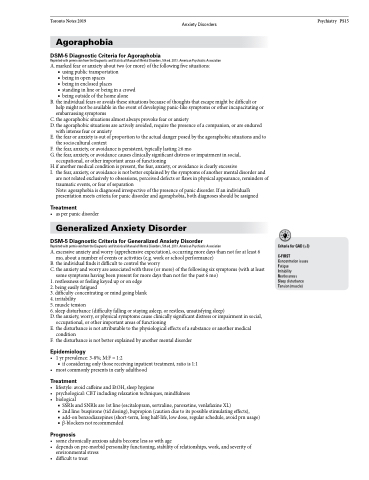Page 1179 - TNFlipTest
P. 1179
Toronto Notes 2019 Anxiety Disorders Agoraphobia
DSM-5 Diagnostic Criteria for Agoraphobia
Reprinted with permission from the Diagnostic and Statistical Manual of Mental Disorders, 5th ed. 2013. American Psychiatric Association
A. marked fear or anxiety about two (or more) of the following five situations: ■ using public transportation
■ being in open spaces
■ being in enclosed places
■ standing in line or being in a crowd
■ being outside of the home alone
B. the individual fears or avoids these situations because of thoughts that escape might be difficult or
help might not be available in the event of developing panic-like symptoms or other incapacitating or
embarrassing symptoms
C. the agoraphobic situations almost always provoke fear or anxiety
D. the agoraphobic situations are actively avoided, require the presence of a companion, or are endured
with intense fear or anxiety
E. the fear or anxiety is out of proportion to the actual danger posed by the agoraphobic situations and to
the sociocultural context
F. the fear, anxiety, or avoidance is persistent, typically lasting ≥6 mo
G. the fear, anxiety, or avoidance causes clinically significant distress or impairment in social,
occupational, or other important areas of functioning
H.if another medical condition is present, the fear, anxiety, or avoidance is clearly excessive
I. thefear,anxiety,oravoidanceisnotbetterexplainedbythesymptomsofanothermentaldisorderand
are not related exclusively to obsessions, perceived defects or flaws in physical appearance, reminders of traumatic events, or fear of separation
Note: agoraphobia is diagnosed irrespective of the presence of panic disorder. If an individual’s presentation meets criteria for panic disorder and agoraphobia, both diagnoses should be assigned
Treatment
• as per panic disorder
Generalized Anxiety Disorder
DSM-5 Diagnostic Criteria for Generalized Anxiety Disorder
Reprinted with permission from the Diagnostic and Statistical Manual of Mental Disorders, 5th ed. 2013. American Psychiatric Association
A. excessive anxiety and worry (apprehensive expectation), occurring more days than not for at least 6 mo, about a number of events or activities (e.g. work or school performance)
B. the individual finds it difficult to control the worry
C. the anxiety and worry are associated with three (or more) of the following six symptoms (with at least
some symptoms having been present for more days than not for the past 6 mo)
1. restlessness or feeling keyed up or on edge
2. being easily fatigued
3. difficulty concentrating or mind going blank
4. irritability
5. muscle tension
6. sleep disturbance (difficulty falling or staying asleep, or restless, unsatisfying sleep)
D. the anxiety, worry, or physical symptoms cause clinically significant distress or impairment in social,
occupational, or other important areas of functioning
E. the disturbance is not attributable to the physiological effects of a substance or another medical
condition
F. the disturbance is not better explained by another mental disorder
Epidemiology
• 1 yr prevalence: 3-8%; M:F = 1:2
■ if considering only those receiving inpatient treatment, ratio is 1:1
• most commonly presents in early adulthood
Treatment
• lifestyle: avoid caffeine and EtOH, sleep hygiene
• psychological: CBT including relaxation techniques, mindfulness • biological
■ SSRIs and SNRIs are 1st line (escitalopram, sertraline, paroxetine, venlafaxine XL)
■ 2nd line: buspirone (tid dosing), bupropion (caution due to its possible stimulating effects),
■ add-on benzodiazepines (short-term, long half-life, low dose, regular schedule, avoid prn usage) ■ β-blockers not recommended
Prognosis
• some chronically anxious adults become less so with age
• depends on pre-morbid personality functioning, stability of relationships, work, and severity of
environmental stress • difficult to treat
Psychiatry PS15
Criteria for GAD (≥3)
C-FIRST Concentration issues Fatigue
Irritability Restlessness
Sleep disturbance Tension (muscle)


